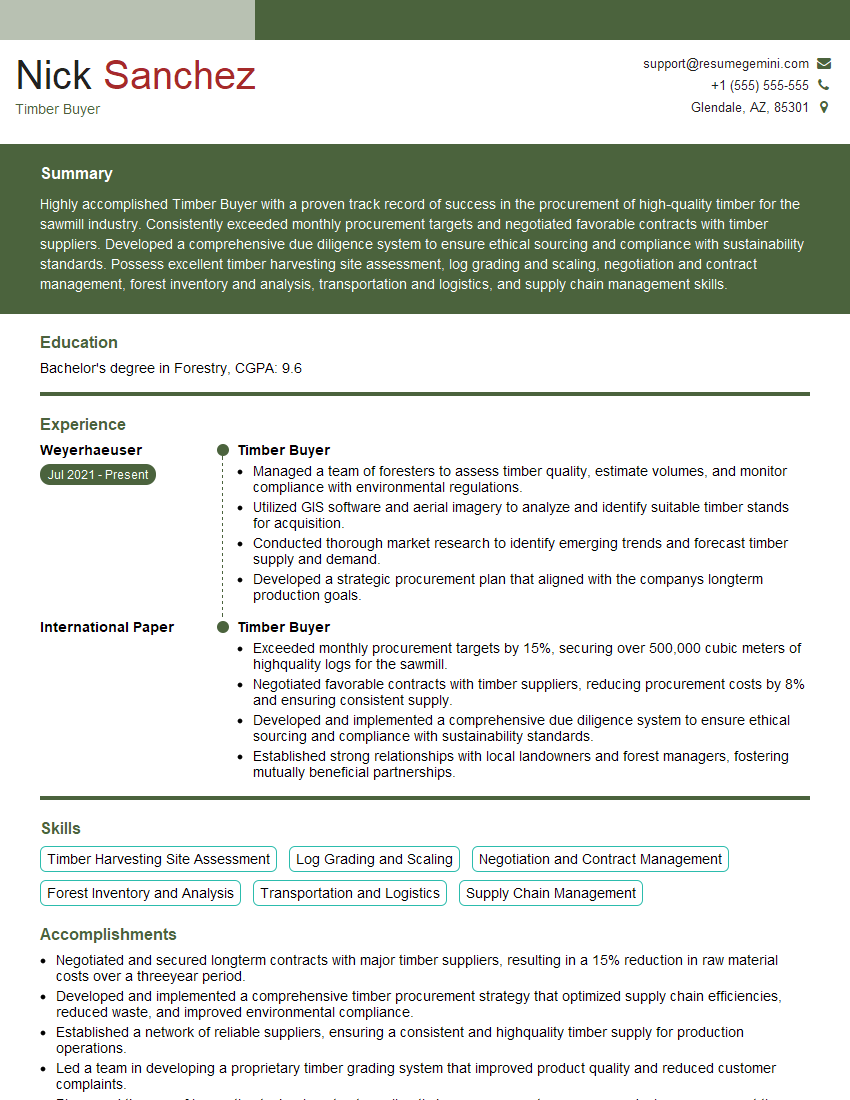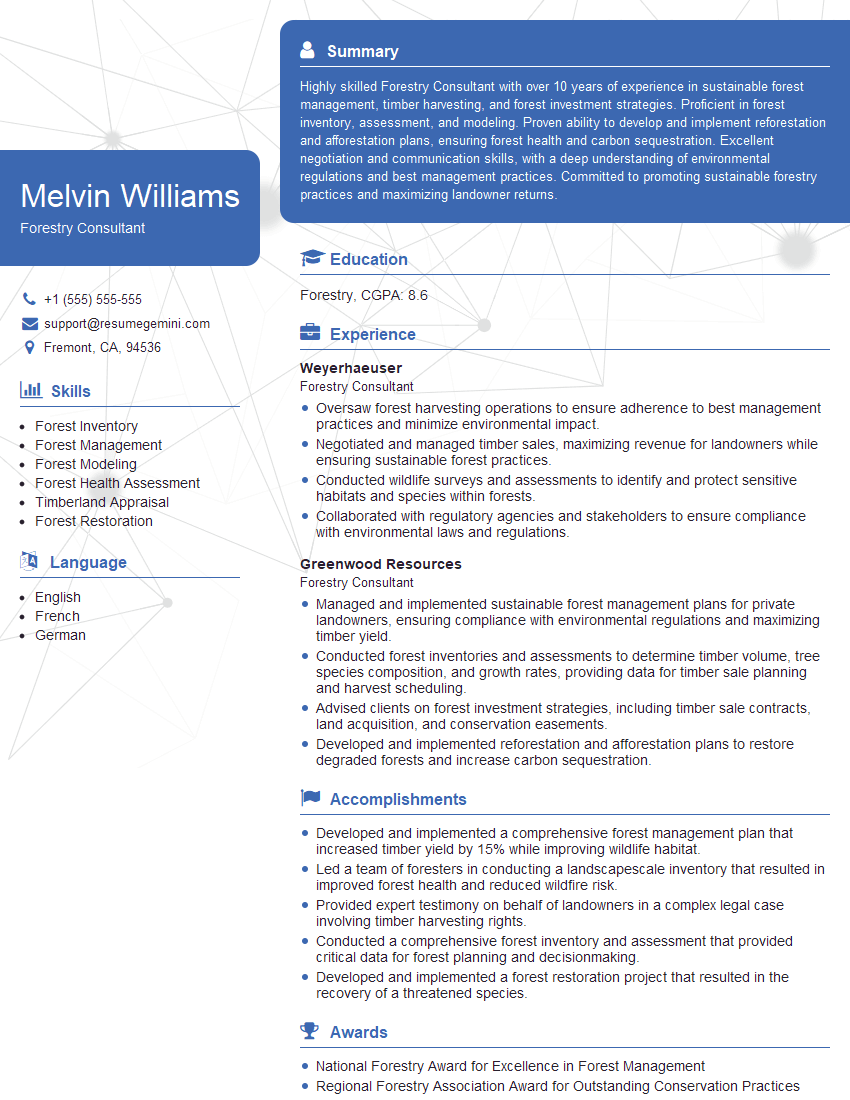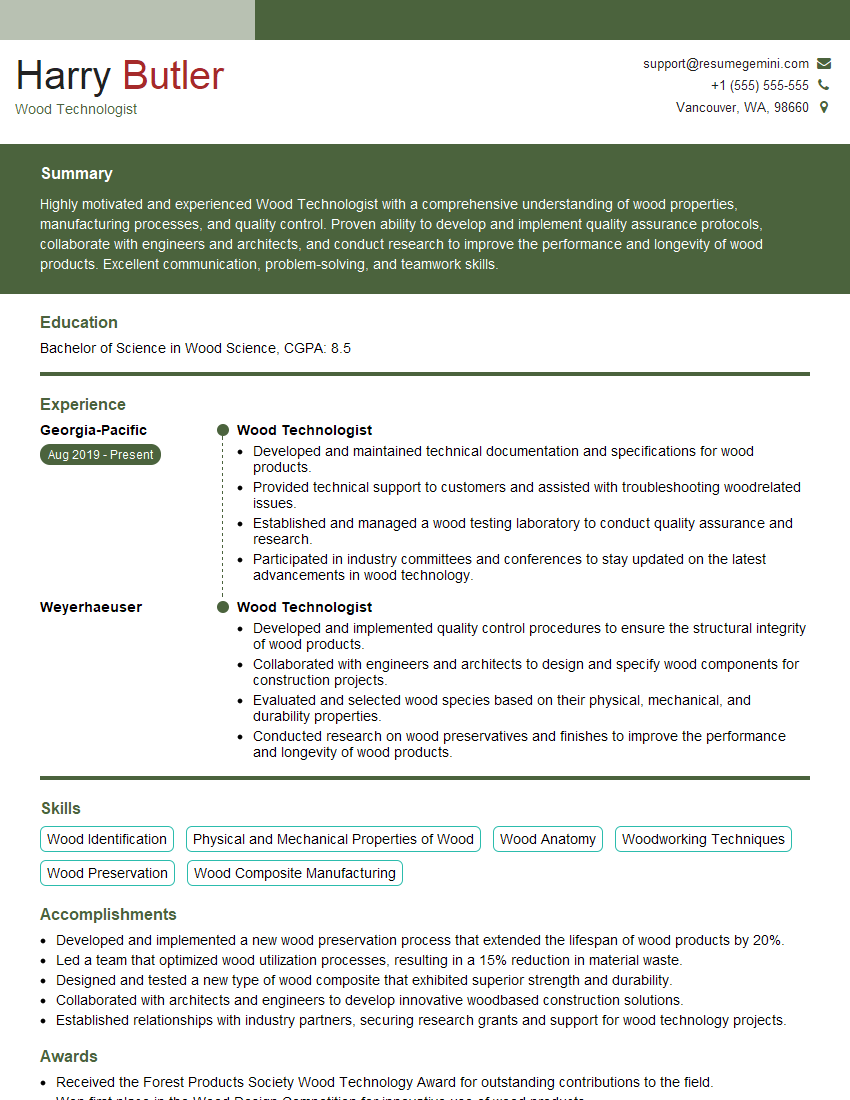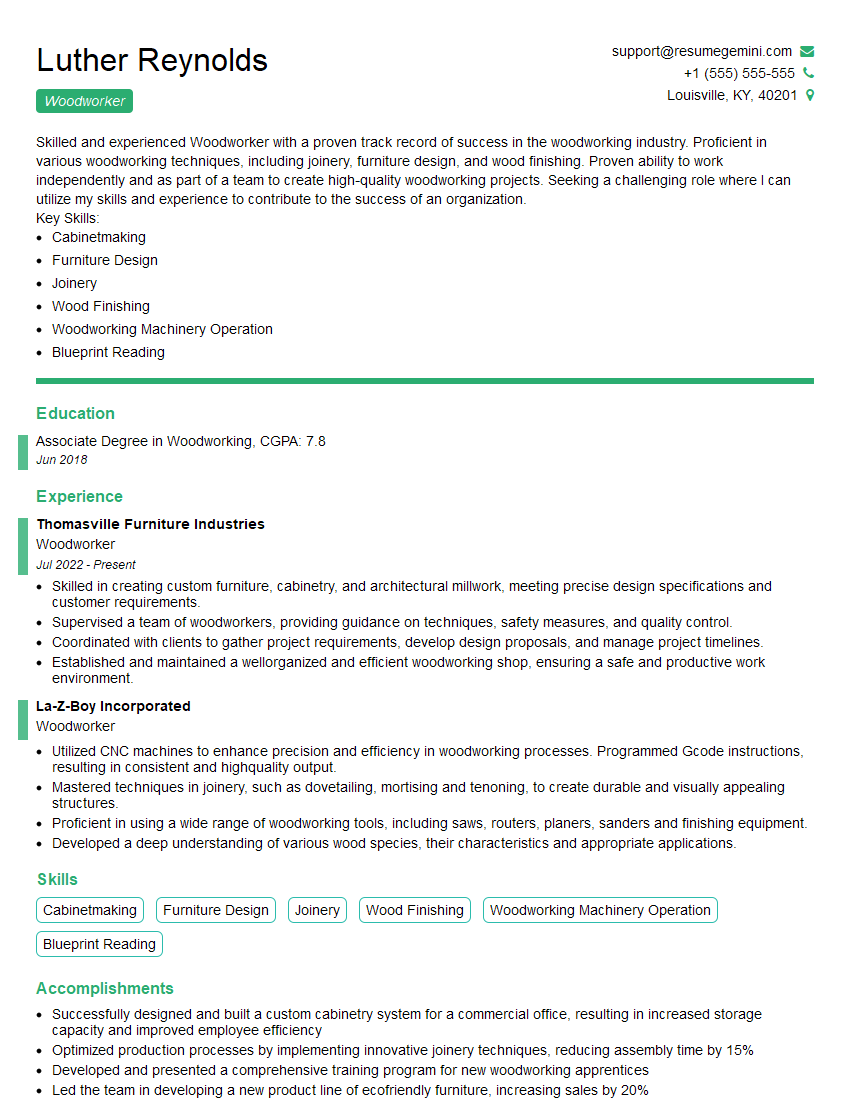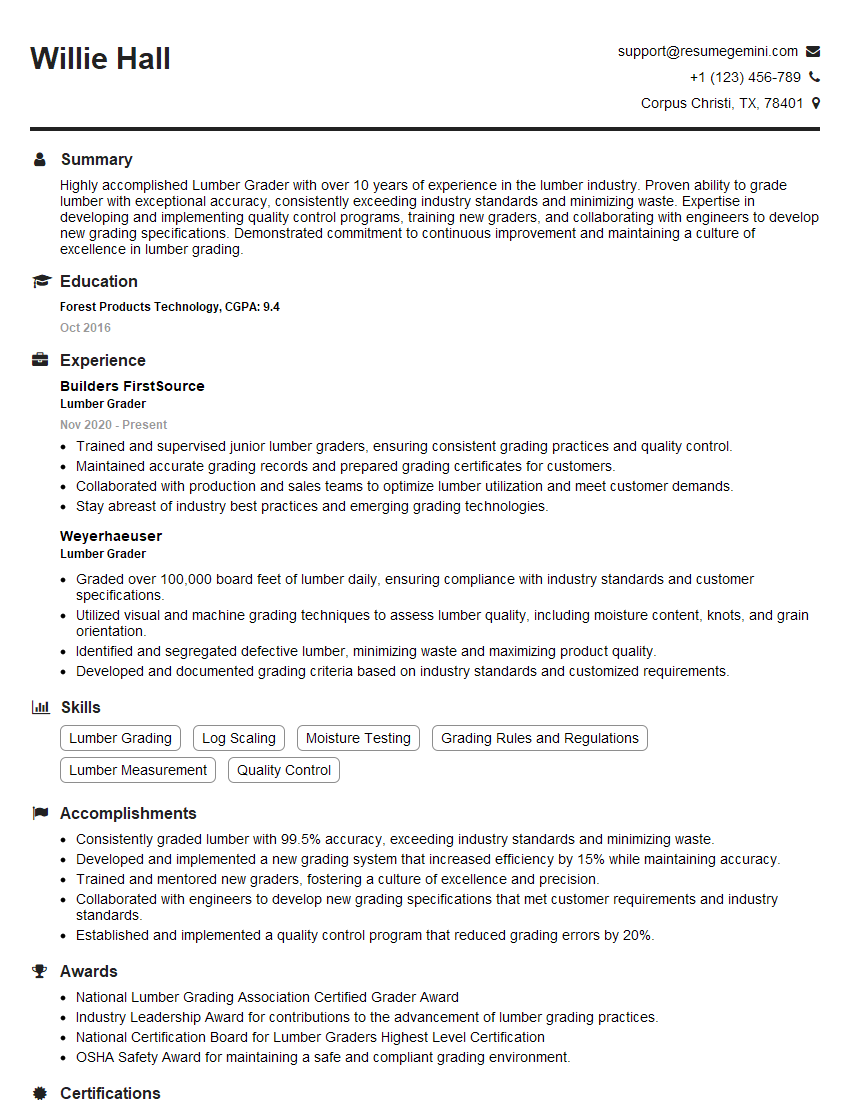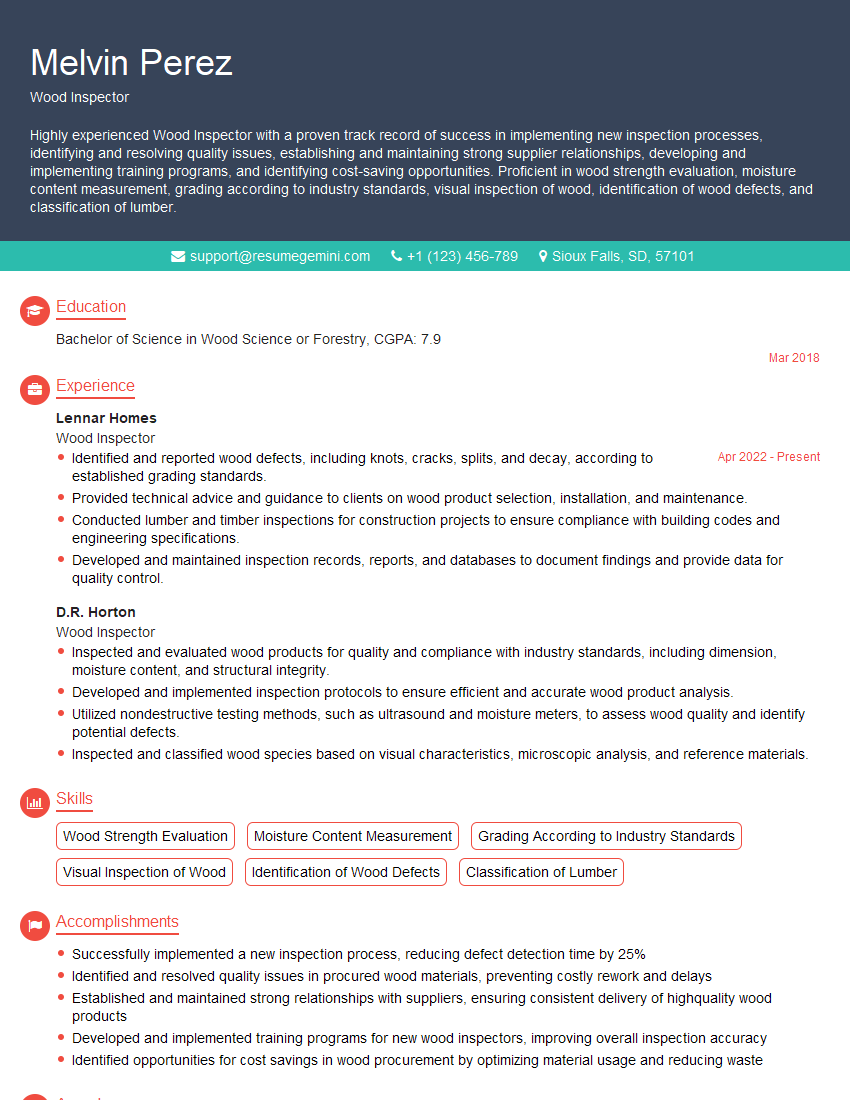Cracking a skill-specific interview, like one for Knowledge of Wood Species and Characteristics, requires understanding the nuances of the role. In this blog, we present the questions you’re most likely to encounter, along with insights into how to answer them effectively. Let’s ensure you’re ready to make a strong impression.
Questions Asked in Knowledge of Wood Species and Characteristics Interview
Q 1. Describe the difference between hardwood and softwood.
The terms “hardwood” and “softwood” are not strictly defined by the actual hardness of the wood, but rather by the type of tree they come from. Hardwoods come from deciduous trees (trees that lose their leaves annually), while softwoods come from coniferous trees (cone-bearing, evergreen trees). This botanical classification generally correlates with hardness, with hardwoods tending to be denser and harder than softwoods, but there are exceptions. For example, Balsa wood is a hardwood, yet incredibly soft, while some pines can be surprisingly hard.
Think of it this way: hardwoods often have broad leaves and grow more slowly, resulting in denser wood. Softwoods generally have needles or scales and grow faster, producing a less dense structure. This difference in growth rate and cellular structure is what contributes to the differences in strength, durability, and workability.
Q 2. Explain the Janka hardness scale and its significance.
The Janka hardness scale measures the resistance of a wood species to denting and wear. It’s determined by measuring the force required to embed a 0.444-inch steel ball halfway into a sample of wood. The higher the Janka hardness score, the harder and more resistant to denting the wood is. This scale is incredibly important in various applications.
For example, a high Janka rating is crucial when selecting wood for flooring, where resistance to dents from dropped objects is critical. Similarly, hardwoods with high Janka scores are preferred for furniture that needs to withstand daily use. Knowing the Janka hardness allows professionals to choose the right wood for specific applications, ensuring durability and longevity of the final product. A common example is that Oak scores high on the Janka scale, hence its popularity in flooring and furniture.
Q 3. What are the key characteristics of oak wood and its common uses?
Oak wood is renowned for its strength, durability, and beautiful grain patterns. It’s a hardwood known for its classic appeal, making it a popular choice in many applications. Key characteristics include:
- High Janka Hardness: Resists dents and wear, suitable for flooring and furniture.
- Strength and Durability: Can withstand significant stress and pressure.
- Attractive Grain Patterns: The distinctive grain adds aesthetic value to any project.
- Variety of Colors and Tones: Ranges from light to dark browns, depending on the species and treatment.
Common uses for oak include flooring, furniture (tables, chairs, cabinets), cabinetry, wine barrels (due to its ability to withstand the tannins), and even musical instruments.
Q 4. Compare and contrast the properties of pine and cedar.
Pine and cedar are both softwoods, but they have distinct properties:
- Pine: Generally more readily available and less expensive than cedar. It is known for its strength (though not as high as oak), straight grain, and ease of workability. It’s often used in construction framing, general carpentry, and less demanding furniture applications.
- Cedar: Prized for its aromatic fragrance, natural insect-repellent properties, and resistance to rot and decay. It is softer than many pines, but its durability in outdoor settings is superior. Cedar is frequently used for outdoor construction, such as fences, siding, and decking, as well as chests and closets, taking advantage of its natural insect-repelling properties.
In summary, Pine is a workhorse softwood, ideal for construction and general woodworking, while Cedar offers unique durability and aromatic qualities, making it a desirable choice for outdoor and specialty applications.
Q 5. Describe the process of wood drying and its impact on wood properties.
Wood drying is a crucial process that reduces the moisture content of freshly cut lumber. This process is essential to prevent warping, shrinking, cracking, and fungal growth. The moisture content of green wood (freshly cut) is typically 30-50%, while dried lumber is usually around 6-12%.
Drying methods include air drying (a slow, natural process) and kiln drying (a faster, controlled process using heat and ventilation). The rate of drying significantly impacts the final properties of the wood. Too rapid drying can lead to internal stresses and cracking, while too slow drying can encourage fungal growth. Proper drying reduces shrinkage and improves the dimensional stability of the wood, making it more suitable for various applications. A well-dried piece of wood is less likely to warp or crack over time, increasing its longevity.
Q 6. What are common wood defects and how do they affect structural integrity?
Several common wood defects can compromise structural integrity. These include:
- Knots: Dense concentrations of wood fibers that occur where branches were attached to the tree trunk. Large or loose knots can weaken the wood and create stress points.
- Checks and Cracks: Splits or fissures in the wood, often caused by drying stresses or physical damage. They can significantly reduce strength and stability.
- Decay: Breakdown of wood caused by fungi. Decayed wood is significantly weaker and unsuitable for structural applications.
- Splits: Longitudinal cracks that run along the grain of the wood. These can weaken the wood’s overall strength.
- Wane: The presence of the bark or lack of wood on the edge of a board. This reduces the usable width of the board and can weaken the structural integrity of the piece.
The severity of these defects dictates their impact on the strength and structural integrity of the wood. In structural applications, careful inspection and selection of wood free from major defects are crucial for safety and durability.
Q 7. Explain the importance of wood grain orientation in furniture construction.
Wood grain orientation is the direction of the wood fibers relative to the final product’s structure. Proper grain orientation is critical in furniture construction for both strength and aesthetics.
For example, arranging wood with the grain running parallel to the longest dimension of a table leg maximizes its strength in compression and bending. If the grain runs perpendicular to the length, it is prone to splitting under stress. Similarly, the grain orientation influences the overall look of the piece, as parallel grain often results in a smoother, more uniform appearance, whereas other directions can create visual texture. The grain orientation affects the wood’s ability to resist warping and twisting. In woodworking, understanding and correctly utilizing grain orientation is critical for creating strong and beautiful furniture that will last.
Q 8. How do different wood species react to various finishes?
Different wood species react to finishes in unique ways due to variations in their porosity, density, and chemical composition. Some woods readily absorb finishes, while others resist them. For example, open-grained woods like oak and ash will absorb stain deeply and unevenly, requiring more coats or the use of a wood conditioner to achieve a consistent finish. Conversely, close-grained woods like maple and birch tend to be less porous and may require more effort to get the stain to penetrate sufficiently.
The type of finish also plays a crucial role. Oil-based finishes penetrate deeper than water-based finishes, which sit on the surface. This is important to consider when choosing a finish for a particular wood. A highly porous wood like redwood might require an oil-based finish to prevent excessive absorption and raise the grain. A harder wood like ebony, with its dense structure, could benefit from a water-based finish for a smooth, even surface. The chemical interactions between the wood and finish can also lead to colour changes or reactions. For example, some woods may react with certain chemicals in finishes to darken significantly, so it’s always prudent to perform a test on an inconspicuous area first.
Understanding these interactions is crucial for achieving desired aesthetic and functional outcomes. A cabinet maker, for example, needs to select appropriate finishes that highlight the wood’s natural beauty while also providing durability and protection.
Q 9. Describe the properties of plywood and its manufacturing process.
Plywood is an engineered wood product composed of thin layers of wood veneer, called plies or veneers, bonded together with adhesive. The plies are typically arranged with the grain of adjacent layers oriented at right angles to one another (cross-banding), creating a strong and stable panel. This cross-grain arrangement dramatically improves the plywood’s strength and dimensional stability compared to solid wood, making it less prone to warping and shrinking.
The manufacturing process involves several key steps:
- Veneer Preparation: Logs are peeled or sliced into thin sheets of veneer using rotary lathes or slicing machines.
- Layering and Bonding: The veneers are carefully arranged with alternating grain directions, and a strong adhesive is applied between each layer.
- Pressing: The layered veneers are placed in a hot press, where heat and pressure bond them together permanently.
- Trimming and Finishing: Once cured, the plywood sheets are trimmed to their desired size and may undergo further finishing processes, such as sanding and edge sealing.
The type and grade of veneer used will determine the overall quality and properties of the plywood. Exterior-grade plywood, for instance, uses waterproof adhesives suitable for outdoor applications, whereas interior-grade plywood is intended for indoor use. Plywood is incredibly versatile, used extensively in construction, furniture making, and various other applications.
Q 10. What is the difference between clear wood and knotty wood?
The terms “clear wood” and “knotty wood” refer to the presence or absence of knots in the wood. Knots are the branches that were present in the living tree. They are essentially the remnants of where a branch grew from the trunk.
Clear wood is characterized by its smooth, uniform texture, essentially free from knots and other imperfections. It’s prized for its superior aesthetic appeal and its ability to be easily worked with without the challenges presented by knots. Clear wood is often used in high-end furniture, fine cabinetry, and applications where a flawless surface is essential. The absence of knots means less potential for weakness in the wood.
Knotty wood, in contrast, contains visible knots. While sometimes considered a defect, knots can add character and visual interest to the wood, often appreciated for their rustic appearance. Knotty wood is often more affordable than clear wood and is commonly used in rustic furniture, flooring, and other applications where the knotty texture is a desirable characteristic. However, the presence of knots can make working with the wood more challenging and can affect its overall strength.
Q 11. How do you identify different wood species by their visual characteristics?
Identifying wood species visually involves observing several key characteristics:
- Grain Pattern: Examine the arrangement of wood fibers – straight, wavy, swirling, or figured. Each species has a distinct grain pattern.
- Color and Tone: Note the overall color, including variations in shade and tone. Some woods exhibit dramatic color changes depending on the light source.
- Texture: Feel the surface; is it smooth, coarse, or rough? Some wood feels oily, whereas others are drier to the touch.
- Growth Rings: Count the growth rings (annual rings) visible in the end grain. The width and spacing of these rings can offer clues to the species and growing conditions.
- Scent: Some woods have distinct aromas when freshly cut. For example, cedar is known for its strong, pleasant scent.
- Figure: Look for distinctive patterns in the grain, such as burl, flame, or quilted figure.
For example, mahogany often displays a rich reddish-brown color and an interlocked grain pattern. Maple typically presents a creamy-white to pale brown color with a fine, uniform texture. Experience and familiarity with various species are key to accurate identification. A good reference book or online resources can also be very helpful.
Q 12. Explain the concept of wood density and its relationship to strength.
Wood density refers to the mass of wood per unit volume. It’s typically expressed as kilograms per cubic meter (kg/m³) or pounds per cubic foot (lbs/ft³). Wood density is closely related to the wood’s strength and other mechanical properties.
Generally, denser woods are stronger and more durable. This is because denser woods have more wood fibers packed into a given space, providing greater resistance to bending, compression, and other stresses. For example, iroko, a tropical hardwood known for its strength and durability, has a relatively high density. Conversely, lighter woods like balsa are less dense and have correspondingly lower strength.
However, density isn’t the only factor determining strength. The arrangement of wood fibers, the moisture content, and the presence of defects also contribute to overall strength. Understanding wood density is crucial for selecting appropriate species for different applications, such as selecting a high-density wood for structural applications like beams or a lighter-density wood for carving.
Q 13. What are common wood preservatives and their applications?
Wood preservatives are chemical treatments designed to protect wood from deterioration caused by biological agents like fungi, insects, and marine borers. The choice of preservative depends on the application and the type of deterioration risk.
Common wood preservatives include:
- Chromated Copper Arsenate (CCA): Historically widely used, but now largely phased out due to environmental concerns.
- Copper Azole (CA): A copper-based preservative increasingly used as a replacement for CCA.
- Copper Naphthenate: Used in some exterior applications and for treating wood against insects.
- Borates: Environmentally friendly preservatives, suitable for various applications.
- Oil-borne preservatives: These are creosote and pentachlorophenol. They offer long-lasting protection, but some are also being phased out.
Preservatives are applied through different methods such as pressure treatment, dipping, brushing, and spraying. Pressure treatment is most effective for achieving deep penetration and long-lasting protection, especially for applications in outdoor and high-risk environments, such as utility poles or marine structures. The application method will affect the longevity and performance of the preservative treatment.
Q 14. Describe the process of wood staining and its purpose.
Wood staining is the process of applying a colored solution to wood to change its appearance, enhancing its natural beauty or creating a desired color effect. It involves penetrating the wood’s surface, typically with a pigment-based solution or dye that interacts with the wood’s cellular structure.
The purpose of wood staining is multifaceted:
- Aesthetic Enhancement: Staining allows for the customization of wood color, allowing you to match furniture or architectural elements to a specific design scheme.
- Highlighting Grain Patterns: Some stains enhance the natural grain patterns of the wood, making them more prominent and visually appealing.
- Color Uniformity: Staining can help create a uniform color across different wood pieces or sections, concealing minor imperfections.
- Protection: While not a primary purpose, some stains provide a degree of protection against moisture and UV damage.
The staining process typically involves preparing the wood surface (sanding), applying the stain evenly, allowing it to penetrate for a specific time, and then wiping off any excess stain. Different types of stains exist, including water-based, oil-based, and gel stains, each having different properties and applications. The choice of stain type greatly impacts the final look and durability of the finish.
Q 15. What are the advantages and disadvantages of using different types of wood glue?
Wood glue selection is crucial for strong, durable joints. Different glues offer varying advantages and disadvantages depending on the project and wood type.
- Polyvinyl Acetate (PVA) Glue: This is the most common type, water-based, relatively inexpensive, and easy to clean up. It’s suitable for most interior woodworking projects but has a lower water resistance than other options. Think of it as the ‘all-purpose’ glue for your home workshop.
- Yellow Wood Glue: A type of PVA glue with improved strength and water resistance compared to basic PVA. It’s ideal for furniture making and other projects where stronger joints are needed.
- Exterior Wood Glue: Specifically formulated for outdoor use, this glue boasts superior water resistance, crucial for projects exposed to the elements. It’s essential for garden furniture or outdoor structures.
- Epoxy Glue: A two-part glue known for its exceptional strength and water resistance. It’s perfect for high-stress applications or when joining dissimilar materials, but it’s more expensive and requires more careful mixing.
- Urea-Formaldehyde (UF) Glue: Primarily used in plywood manufacturing, UF glue is strong and water-resistant but is less common for individual projects.
Choosing the right glue depends heavily on the project’s demands. For example, a simple bookshelf might only need PVA glue, while a boat repair necessitates epoxy glue for its superior waterproof properties.
Career Expert Tips:
- Ace those interviews! Prepare effectively by reviewing the Top 50 Most Common Interview Questions on ResumeGemini.
- Navigate your job search with confidence! Explore a wide range of Career Tips on ResumeGemini. Learn about common challenges and recommendations to overcome them.
- Craft the perfect resume! Master the Art of Resume Writing with ResumeGemini’s guide. Showcase your unique qualifications and achievements effectively.
- Don’t miss out on holiday savings! Build your dream resume with ResumeGemini’s ATS optimized templates.
Q 16. How do environmental conditions affect wood properties?
Environmental conditions significantly impact wood properties. Think of wood as a living material that continues to respond to its environment even after it’s been harvested.
- Moisture Content: Wood absorbs and releases moisture, causing it to swell and shrink. High humidity leads to swelling, potential warping and cracking, while low humidity leads to shrinkage, potentially creating gaps in joints.
- Temperature: Extreme temperature fluctuations can cause similar issues to moisture changes, putting stress on the wood’s structure. Rapid temperature changes can be particularly problematic.
- Sunlight (UV Exposure): Sunlight degrades the wood’s lignin and cellulose, leading to discoloration, weakening, and potential cracking. This is why outdoor furniture often needs UV protection.
- Insects and Fungi: Certain environmental conditions favor the growth of insects and fungi that can damage wood, causing decay and weakening. This is why proper preservation is critical in high-humidity areas.
Understanding these environmental influences is vital for selecting appropriate wood species for specific applications and implementing proper preservation techniques. For example, outdoor decking should be made from a naturally durable wood like Ipe or treated lumber to resist rot and decay.
Q 17. Explain the concept of wood shrinkage and swelling.
Wood shrinkage and swelling are a natural consequence of wood’s cellular structure. Wood cells contain moisture, and as this moisture content changes, the wood dimensions change accordingly.
Shrinkage: Occurs when wood loses moisture, usually as it dries. The cells collapse slightly, resulting in a reduction in size. Shrinkage is most pronounced in the tangential direction (around the tree rings) and less so in the radial direction (along the tree rings).
Swelling: Occurs when wood absorbs moisture. The cells re-hydrate, expanding in size. Again, swelling is most significant in the tangential direction.
This shrinkage and swelling can cause problems in woodworking. Understanding the direction of the grain and controlling the moisture content is critical for preventing warping, splitting, and other issues. Proper kiln-drying of lumber is a key step in minimizing these problems in finished products. For example, a poorly dried table top may crack over time due to uneven shrinkage.
Q 18. Describe different methods of wood joinery.
Wood joinery refers to the methods of connecting pieces of wood without using screws or nails. Various methods exist, each with its strengths and weaknesses.
- Mortise and Tenon: A strong joint where a tenon (projection) fits into a mortise (hole). Variations include through tenons, blind tenons, and wedged tenons, providing different levels of strength and aesthetics.
- Dovetail Joint: An incredibly strong and visually appealing joint where interlocking tails and pins interlock. Used frequently in drawers and high-end furniture.
- Lap Joint: A simple joint where overlapping pieces are glued together. Variations include half-lap, miter lap, and finger lap joints, offering different strengths and appearances.
- Dado Joint: A joint where a groove (dado) is cut into one piece and another piece fits snugly into it. Great for shelving and similar applications.
- Bridle Joint: This joint involves a projecting part (tongue) and a receiving hole or notch. Commonly seen in furniture frames and legs.
The choice of joinery depends on the project’s strength requirements, aesthetics, and the skill of the woodworker. A simple lap joint might suffice for a small shelf, while intricate dovetails are reserved for more demanding projects.
Q 19. What is the difference between lumber and timber?
The terms ‘lumber’ and ‘timber’ are often used interchangeably, but there are subtle distinctions.
Lumber: Generally refers to smaller pieces of wood, typically less than 5 inches thick, intended for construction and general woodworking. It’s often sold in standard lengths and sizes.
Timber: Typically refers to larger, stronger pieces of wood, often used in structural applications like beams, posts, and framing for larger structures. It often involves larger dimensions and more specialized processing.
Essentially, lumber is the everyday wood used for building things, while timber is what you use for significant structural components.
Q 20. What are the sustainability considerations in wood selection?
Sustainability is paramount in wood selection. Choosing wood responsibly minimizes environmental impact and ensures the long-term health of forests.
- Source: Opt for wood from sustainably managed forests that prioritize replanting and biodiversity. Avoid wood from illegally logged areas.
- Species: Select fast-growing, readily renewable wood species. Some species grow more quickly and sustainably than others, reducing the environmental burden of harvesting.
- Certification: Look for certified wood, such as FSC (Forest Stewardship Council) certified wood, which ensures sustainable forest management practices.
- Waste Reduction: Minimize waste during processing and construction. Efficient manufacturing processes that utilize all parts of the tree are beneficial.
- Transportation: Consider the transportation distance of the wood, selecting locally sourced wood whenever feasible to lower carbon emissions.
By prioritizing sustainable wood choices, we contribute to responsible forestry and the conservation of our natural resources. Making informed decisions can make a big difference.
Q 21. Explain the concept of wood certification (e.g., FSC).
Wood certification, such as the FSC (Forest Stewardship Council) certification, provides assurance that wood comes from responsibly managed forests. These certifications involve independent audits and verification of sustainable forestry practices.
FSC Certification: This is a widely recognized certification that ensures wood originates from forests managed according to strict environmental and social standards. The standards cover various aspects, including biodiversity conservation, soil protection, water management, and the rights of workers and local communities.
Other certification schemes exist, but the FSC is a globally recognized standard that promotes responsible forest management and traceability. Choosing FSC certified wood helps support sustainable forestry and reduce the risk of purchasing wood from illegally harvested sources. It gives consumers and businesses the peace of mind that their wood choices are environmentally sound.
Q 22. How do you determine the appropriate wood species for a specific application?
Selecting the right wood species is crucial for a project’s success. It hinges on understanding the desired properties – strength, durability, aesthetics, workability, and cost. Think of it like choosing the right tool for a job: you wouldn’t use a screwdriver to hammer a nail.
- Strength and Durability: For structural applications like beams or flooring, hardwoods like oak, hickory, or ash are ideal due to their high density and strength. Softwoods like pine are suitable for less demanding applications.
- Aesthetics: The appearance is key for furniture or cabinetry. The rich grain of walnut or mahogany offers a luxurious look, while maple provides a clean, bright aesthetic.
- Workability: Some woods are easier to work with than others. Pine and fir are relatively soft and easy to cut and shape, while hardwoods require more specialized tools and skill.
- Cost: Exotic hardwoods like ebony or rosewood are stunning but come with a significantly higher price tag compared to readily available domestic species.
- Specific Application: Outdoor applications demand rot resistance. Cedar and redwood are naturally resistant to decay, making them suitable for decks and fences. For boat building, teak is prized for its water resistance and durability.
For example, building a sturdy outdoor deck would necessitate a rot-resistant and durable hardwood like redwood or cedar. Meanwhile, crafting delicate jewelry boxes might call for a fine-grained, easily worked wood such as cherry or maple.
Q 23. Describe the process of selecting and grading lumber for a construction project.
Selecting and grading lumber involves a multi-step process ensuring quality and suitability for the intended project. It’s like choosing the right ingredients for a recipe—the quality of the ingredients directly impacts the final product.
- Species Selection: Based on project needs (strength, aesthetics, etc.), the appropriate wood species is chosen as outlined in the previous answer.
- Grade Selection: Lumber grades (like Select, No. 1, No. 2, etc.) categorize wood based on the number and size of knots, checks, and other imperfections. Higher grades have fewer imperfections and are more expensive. For example, furniture typically requires higher grades for a cleaner finish, whereas framing might utilize lower grades that still meet structural requirements.
- Visual Inspection: Lumber is carefully examined for defects such as knots, cracks, splits, decay, and warping. This ensures that the material meets the chosen grade standards.
- Moisture Content Check: Moisture content is crucial. Too much moisture can lead to warping and cracking. A moisture meter is used to ensure the lumber is properly dried to prevent future problems.
- Sizing and Cutting: Lumber is often cut to the precise dimensions required for the project, minimizing waste and ensuring a perfect fit.
For instance, a high-end furniture project would necessitate selecting high-grade, clear lumber, while constructing a simple shed could utilize lower-grade lumber with minimal visual imperfections. Always remember to account for potential shrinkage and expansion due to changes in humidity.
Q 24. Explain the difference between various types of wood finishes (e.g., oil, varnish, lacquer).
Wood finishes protect and enhance the wood’s appearance, much like sunscreen protects our skin. Each finish offers different properties and aesthetics.
- Oil Finishes (e.g., linseed oil, tung oil): Penetrate the wood, enhancing its natural beauty and providing some protection. They’re easy to apply and repair but offer less durability and water resistance than other finishes. They are also easier to touch up.
- Varnish Finishes: Create a hard, durable, and water-resistant surface. They offer excellent protection against scratches and wear but can be more challenging to apply and repair than oils. They build up several layers of protection.
- Lacquer Finishes: Dry quickly, offering a smooth, hard finish with good water resistance. They are often used for furniture and musical instruments where a smooth surface is crucial. However, they are more susceptible to chipping than varnish.
The choice depends on the application and desired level of protection. For example, a kitchen countertop might benefit from the durability of a varnish, while a rustic table might be better suited to the natural look of an oil finish. A fine piece of furniture might benefit from multiple layers of lacquer to enhance the smoothness and durability.
Q 25. What are the common pests and diseases affecting wood, and how are they treated?
Wood is susceptible to various pests and diseases, impacting its structural integrity and aesthetics. Prevention is key.
- Common Pests: Termites, carpenter ants, wood borers. These insects can cause extensive damage by tunneling through the wood.
- Common Diseases: Fungal decay (dry rot, brown rot), caused by fungi thriving in damp conditions. This can weaken the wood, making it brittle and prone to collapse.
Treatment:
- Prevention: Proper ventilation, moisture control (avoiding excessive dampness), and using pressure-treated lumber for outdoor applications are crucial preventative measures.
- Pest Control: Professional pest control services are often necessary to eliminate infestations. This often involves treating the wood with insecticides or fumigation. For minor infestations, localized treatments might suffice.
- Disease Treatment: Removing affected wood and treating the surrounding area with fungicides is essential. In advanced cases, complete replacement might be unavoidable.
Regular inspection is essential. Early detection is key to limiting the damage and cost of treatment. Think of it like regular checkups for your health – early diagnosis prevents more serious problems.
Q 26. Describe your experience with using various woodworking tools.
My experience spans a wide range of woodworking tools, from hand tools to power equipment. Proficiency in using these tools is essential for precision and safety.
- Hand Tools: I’m proficient with chisels, hand planes, saws (hand saws, coping saws, tenon saws), mallets, and various measuring and marking tools. These tools allow for intricate detail work and precise cuts. For example, a hand plane allows for smooth surfacing, something difficult to achieve consistently with power tools.
- Power Tools: I’m skilled in operating table saws, miter saws, routers, jointers, planers, band saws, and drills. These tools greatly increase efficiency and allow for complex shapes and cuts. Safety is paramount while using these tools, and proper training is a must.
I find that a good woodworker understands the strengths and limitations of each tool and chooses the appropriate tool for the task at hand. This approach ensures precision, efficiency, and minimizes the risk of damage to the material or injury to the operator.
Q 27. How do you ensure the safety of yourself and others when working with wood?
Safety is my top priority. Woodworking involves sharp tools and potentially hazardous machinery. A careless moment can lead to serious injury.
- Personal Protective Equipment (PPE): I consistently use safety glasses, hearing protection (especially with power tools), dust masks (to avoid inhaling wood dust), and appropriate clothing (avoiding loose clothing or jewelry that could get caught in machinery).
- Tool Maintenance: Regularly maintaining and sharpening tools ensures they function correctly and reduces the risk of accidents. A dull tool requires more force, increasing the risk of slippage and injury.
- Work Area Safety: Maintaining a clean and organized workspace prevents trips and falls, a common cause of accidents in woodworking shops. Tools should be properly stored when not in use.
- Machine Safety: Following manufacturer’s instructions carefully when operating power tools is critical. Guards should be in place, and proper techniques should be used to avoid kickbacks or other hazards.
- Emergency Preparedness: Having a first-aid kit readily available and knowing basic first-aid procedures is essential.
Safety isn’t just about preventing injury; it’s about working efficiently and confidently, knowing that you’re minimizing risks.
Q 28. What are your strategies for identifying and resolving challenges in woodworking projects?
Woodworking presents unique challenges. My approach involves a systematic problem-solving strategy.
- Identify the Problem: Carefully assess the issue. Is it a design flaw, a tool malfunction, a material defect, or something else?
- Gather Information: Research potential solutions. Consult reference materials, experienced woodworkers, or online resources.
- Develop Solutions: Brainstorm potential solutions. Consider different approaches and weigh their pros and cons.
- Test and Refine: Experiment with the chosen solution. Make adjustments as needed to optimize the outcome.
- Document and Learn: Record the problem, solution, and lessons learned. This helps improve future projects and prevents repeating past mistakes.
For example, if a joint isn’t fitting properly, I’d check my measurements, the accuracy of the cuts, the type of joint, and the wood’s moisture content. I might adjust the design, redo the cuts, use a different type of joint, or let the wood acclimate before trying again. Each challenge presents a learning opportunity to refine my skills and approach.
Key Topics to Learn for Knowledge of Wood Species and Characteristics Interview
- Wood Anatomy and Structure: Understanding the cellular composition of wood (e.g., hardwoods vs. softwoods, grain patterns, growth rings), its impact on properties, and how to identify different wood structures microscopically.
- Physical and Mechanical Properties: Learning about density, strength (compressive, tensile, shear), hardness, stiffness, elasticity, and workability of various wood species. Knowing how these properties influence applications in furniture making, construction, and other industries.
- Wood Identification: Mastering techniques for identifying different wood species based on visual characteristics (color, grain, texture, odor), macroscopic features, and potentially using specialized tools.
- Wood Defects and Their Impact: Understanding common wood defects (knots, cracks, shakes, decay) and how they affect the strength, durability, and aesthetic value of wood. Knowing methods for assessing and mitigating these defects.
- Wood Preservation and Treatment: Familiarizing yourself with methods for protecting wood from decay, insect infestation, and weathering. This includes understanding the use of preservatives and treatments, and their impact on wood properties.
- Sustainable Forestry Practices: Demonstrating awareness of responsible sourcing and the environmental impact of wood harvesting and processing. Understanding sustainable forestry certifications and practices is increasingly important.
- Wood Finishing and Application Techniques: Understanding various finishing techniques (staining, sealing, painting) and their impact on the final product. This also includes knowledge of appropriate tools and techniques for specific wood species and applications.
- Problem-Solving with Wood: Be prepared to discuss scenarios where you’ve had to overcome challenges related to wood selection, processing, or application due to specific wood properties or defects.
Next Steps
Mastering knowledge of wood species and characteristics is crucial for career advancement in fields like woodworking, forestry, construction, and design. A strong understanding of these concepts will significantly improve your ability to solve practical problems and contribute effectively to your chosen profession. To maximize your job prospects, creating an ATS-friendly resume is essential. ResumeGemini is a trusted resource to help you build a professional and effective resume that highlights your skills and experience. Examples of resumes tailored to showcasing expertise in Knowledge of Wood Species and Characteristics are available to guide you.
Explore more articles
Users Rating of Our Blogs
Share Your Experience
We value your feedback! Please rate our content and share your thoughts (optional).
What Readers Say About Our Blog
Interesting Article, I liked the depth of knowledge you’ve shared.
Helpful, thanks for sharing.
Hi, I represent a social media marketing agency and liked your blog
Hi, I represent an SEO company that specialises in getting you AI citations and higher rankings on Google. I’d like to offer you a 100% free SEO audit for your website. Would you be interested?
